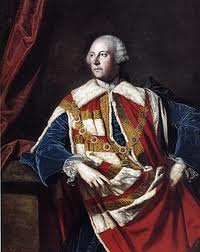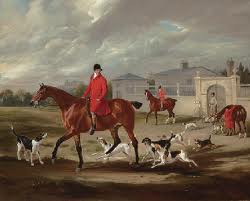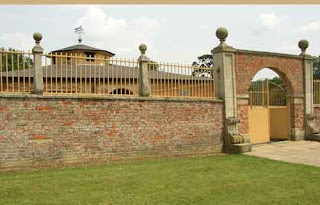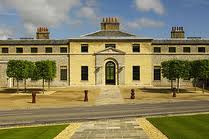 |
| John Russel, 4th Duke of Bedford Sir Joshua Reynolds |
Aristocratic gentlemen have always enjoyed a good hunt, one of the finest being the Oakley Hunt, formed by the 4th Duke of Bedford at Woburn Abbey in 1793.
The Field Book (1833) says: “The Duke of Bedford’s is an immense establishment, upon a scale of too great an extent for particular description; as it includes tennis court, riding house, etc., etc. In one stone-fronted building of two hundred and sixty-six feet in length, there are stalls for thirty-six hunters, and eleven loose boxes for sick or lame horses. The kennel is in length four hundred and five feet; having the boiling house in the centre, with feeding rooms adjoining, and a granary behind. On the right of the centre are apartments for two kennel-keepers, two long lodging-rooms for the hunting hounds; with flues running along the wall, to preserve an equal temperature in the severity of the winter season; spacious courts to each, furnished with a fountain in the middle, for the hounds to drink at; and water cocks fixed at proper distances, to cleanse the pavement when it may be required. Adjoining to these, are seven hospitals for sick and lame hounds, with yards to each. On the left, are divisions for litter, straw, and stores of any kind; with eleven apartments for bitches and puppies, and yards to each. There are, also, eleven of a similar description, for bitches in pup; and a large division for bitches at heat. In the front, is a reservoir of water which supplies the fountains and different cocks in the several yards within. Behind the whole, is a large airing ground, flesh-house, and all requisite conveniences. The huntsman’s dwelling is a handsome building adjoining. The number of hunting hounds kept in the kennel, is usually from sixty to seventy couples.”
 |
| The Oakley Hounds |
Yet by the end of the eighteenth century, fox-hunting was feeling the pinch of costs. The Napoleonic Wars brought heavy taxes and the Duke of Bedford, with his Oakley hounds, was taxed on an additional twenty-five more servants and twenty-seven more horses on top of an existing twenty-six servants and thirty horses. On March 20th, 1798, the Duke wrote to Samuel Whitbread: ‘I will continue my subscription of 500 [pounds sterling] so long as the hounds are kept at Oakley and Mr Pitt leaves me the money’. Difficulties ensued, and in 1809 the Duke of Bedford’s eldest son rescued the hunt when the expense of the hounds totalled 2,850 [pounds sterling] per year. ‘You will be glad to hear Tavistock has determined to undertake the arduous task,’ the Duke wrote on April 4th, ‘although it is rather hard on him to exact the sacrifice of half his income for the gratification of a few gentlemen who are unwilling to contribute anything towards their own amusement.”
 |
| Thomas Goosey and the Belvoir Hounds Leaving the Kennels |
Other titled kennel owners were the Duke of Rutland and the Duke of Richmond. From The Sportsman’s Library by John Mills 1845:
“The best constructed kennel, taking it in every point of view, that I have seen, is that belonging to His Grace the Duke of Rutland, at Belvoir Castle; although there are others upon a grander scale.
 |
| Belvoir Kennels |
The superb edifice of the Duke of Richmond at Goodwood, cost no less a sum than thirteen thousand pounds, in its erection. His Grace was his own architect and builder; and the magnificent design, and the perfection of its arrangements, show how capable he was of accomplishing his task.
 |
| The kennels at Goodwood |
“The distribution of the building is in five compartments: two of them thirty-six feet by fifteen; and three more, thirty by fifteen. In each of these are openings at the top, for the admission of external air when necessary; and stoves, to qualify the air when too cold. There are supplies of water, and drains into a tank of great depth below, full of rain water; from the surface of which, to the rise of the earth, is eleven feet: so that no unpleasantness arises from stench; and the whole can be occasionally cleared off by drains to more dependent depths and dung pits, where it becomes contributory to the purposes of agriculture. Round the whole pavement, five feet wide, airing yards, places for breeding, and other conveniences make a part of each wing. To produce a uniformity of elegance, neatness, and perfection, the huntsman and whipper-in have each a parlour, kitchen, and sleeping-room, appropriated to their own particular purposes.”
 |
| The Belvoir Hunt 2003 |
As we have read, owning a working hunt kennel was costly then, and is even costlier now. Edmund Yates, in his book, The Business of Pleasure (1879) put it this way – “In summing-up the question of expense, it will be well to bear in mind the axiom of a well-known sportsman of bygone days, that `a master of hounds will never have his hand out of his pocket, and must always have a guinea in it;’ but it may be laid down as a principle that the expense generally depends upon the prudence, experience, and interest possessed by the owner of the pack and the stud. Two men have worked different counties in a season, one at the fourth of the expense incurred by the other, and the difference in sport has been inappreciable. It may, however, be taken as a fact, that the expenses of a fox-hound pack for hunting twice a week, including cost of hounds, horses, huntsmen, and stable-attendants, will be about fifteen hundred; and for three times a week, two thousand pounds.”
In our present day, the cost of owning and maintaining a pack is one obstacle – the political climate against hunting is another thing entirely. Still, the hunts, and hunters, hang on. The Oakley Hunt is still going and you can visit their website here. The Duke of Rutland’s Belvoir Hunt remains active, as well. Visit their site here. The kennels at Goodwood are now a private members club.